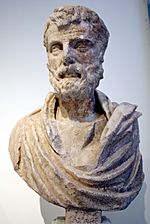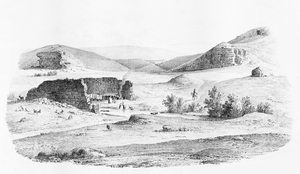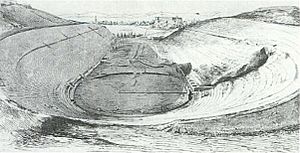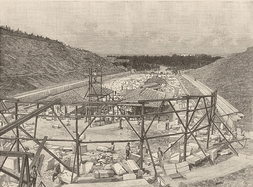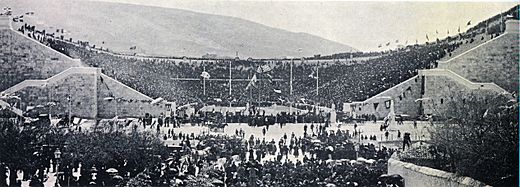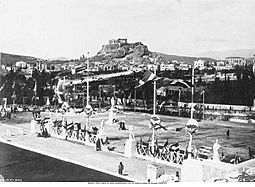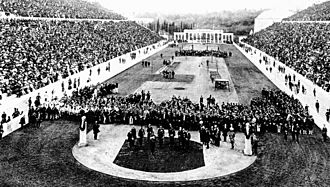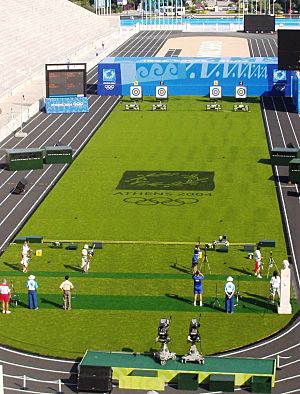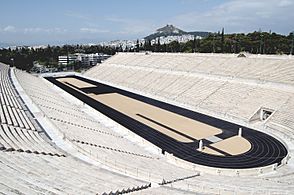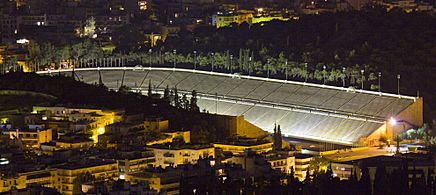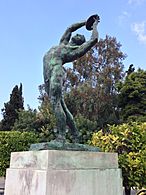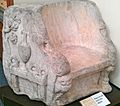Panathenaic Stadium facts for kids
|
Kallimarmaro
|
|
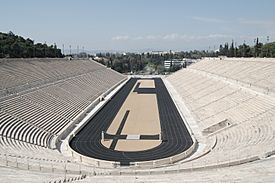
The stadium in April 2009
|
|
| Location | Athens, Greece |
|---|---|
| Coordinates | 37°58′6″N 23°44′28″E / 37.96833°N 23.74111°E |
| Public transit | Template:OASA icons Template:OASA icons Template:OASA icons Template:OASA icons Zappio tram stop |
| Owner | Hellenic Olympic Committee |
| Capacity | 144 AD: 50,000 1896: 80,000 current: 45,000 |
| Record attendance | 80,000 (AEK Athens vs Slavia Prague, 1968) |
| Construction | |
| Built | 6th century BC (racecourse) c. 330 BC (in limestone by Lykourgos) c. 144 AD (in marble by Herodes Atticus) |
| Renovated | 1896 |
| Architect | Anastasios Metaxas (1896 renovation) |
The Panathenaic Stadium (also called Panathinaiko or Kallimarmaro) is a famous stadium in Athens, Greece. It is one of the most important historical places in Athens. This stadium is special because it is the only one in the world built entirely from marble.
A simple racecourse was first built here around 600 BC. Later, an Athenian leader named Lykourgos built a proper stadium around c. 330 BC. It was mainly used for the Panathenaic Games. Much later, in 144 AD, a rich Roman senator named Herodes Atticus rebuilt it using marble. It could hold 50,000 people.
After the 300s AD, the stadium was mostly left empty. It was dug up again in 1869. It then hosted the Zappas Olympics in 1870 and 1875. After being fixed up, it was used for the opening and closing ceremonies of the first modern Olympic Games in 1896. It also hosted four of the nine sports played there. The stadium was used for many things in the 1900s. It was an Olympic venue again in 2004. Today, it is the finish line for the yearly Athens Classic Marathon. It is also where the Olympic flame is handed over to the next host country.
Contents
Location of the Stadium
The stadium was built in a natural valley between two hills, Agra and Ardettos. It was south of the Ilissos river. Today, it is in the center of Athens, in the Pangrati area. It is east of the National Gardens and the Zappeion Exhibition Hall. It sits between the pine-covered hills of Ardettos and Agra.
Before the 1950s, a river flowed in front of the stadium's entrance. There was also a spring and other important places nearby.
History of the Panathenaic Stadium
Since the 6th century BC, there was a racecourse at this spot. It was where the Panathenaic Games took place. These were religious and sports events held every four years to honor the goddess Athena. Back then, there were no seats. People just sat on the hillsides to watch.
Lykourgos's Stadium
In the 300s BC, the Athenian leader Lykourgos built a stadium. It was about 850-foot (260 m) long and made of limestone. Stone benches were placed around the track. The track itself was 669 feet (204 m) long and 110 feet (34 m) wide.
Lykourgos convinced the land owner, Deinas, to give the land to the city. He then leveled the valley to build the stadium. Records show that Eudemus of Plataea gave many oxen for building the stadium and a theater. This shows it was a very big project. The stadium built by Lykourgos was likely finished for the Panathenaic Games in 330/329 BC. Some historians think Lykourgos might have improved an older stadium instead of building a brand new one. It probably only had stone seats for a few important people.
Herodes Atticus's Reconstruction
Herodes Atticus was a powerful Athenian who lived in Rome. He built many structures in Greece. In Athens, he is famous for rebuilding the Panathenaic Stadium. He likely started building it around 138 AD, after his father passed away. It is believed he promised to fix up the stadium for the Panathenaic festival in 139/140 AD. The stadium was finished four years later, around 143 or 144 AD.
The new stadium was built completely out of Pentelic marble. It used very little concrete. This was a time when Greek culture was becoming popular again. The stadium was a very Greek type of building, but it was huge like Roman stadiums. It could hold 50,000 people, similar to the Stadium of Domitian in Rome. Older Greek stadiums were much smaller. The stadium's seating area was decorated with owl carvings, which represent the goddess Athena.
Stadium Left Empty
In the late 300s AD, the Roman Emperor Theodosius I banned many ancient festivals. After this, the stadium was left empty and fell into ruin. Over time, people forgot how important it was, and a field of wheat grew over the site.
During the time of the Crusaders in Athens, knights held events at the stadium. Travelers in the 1400s saw rows of white marble benches and parts of the entrance. The marble from the old stadium was taken and used to build other buildings.
Modern Reconstruction
Digging Up the Stadium and Zappas Olympics
After Greece became independent, people started digging up the stadium in 1836. They found parts of Herodes Atticus's stadium. More detailed digging was done by architect Ernst Ziller in 1869–70. The Zappas Olympics, an early attempt to bring back the ancient Olympic Games, were held here in 1870 and 1875. These games were paid for by a Greek helper named Evangelis Zappas. About 30,000 people watched these games.
1896 Olympics
The Greek government asked a Greek businessman from Egypt, George Averoff, to pay for fixing up the stadium again. This was for the 1896 Olympics. An architect named Anastasios Metaxas made a plan to rebuild it in the mid-1890s. He copied the size and design of the old stadium from the 100s AD. It was rebuilt with Pentelic marble and looked very much like the ancient one. Averoff gave 920,000 drachmas for this project. To thank him, a statue of Averoff was put up outside the stadium on April 5, 1896. It is still there today.
The stadium hosted the opening and closing ceremonies of the 1896 Olympics. On April 6, the first modern Olympic Games officially began. It was Easter Monday and also the day Greece celebrates its independence. About 80,000 people filled the stadium, including the King of Greece and his family. The athletes stood on the field, grouped by their countries. After a speech, the King officially opened the games. The stadium was also used for athletics, gymnastics, weightlifting, and wrestling.
-
Entrance of participants to the stadium. The Acropolis is seen in the background.
20th Century Events
- 1906 Olympics
The stadium hosted the 1906 Intercalated Games from April 22 to May 2.
- AEK Basketball Club
From the mid-1960s, the stadium was used by the AEK Basketball Club. On April 4, 1968, the final game of the 1967–68 FIBA European Cup Winners' Cup was held here. AEK beat Slavia Prague in front of about 80,000 seated fans. Another 40,000 people stood outside. This game is believed to hold the world record for the most people at a basketball game.
- Government Events
During the time of the Greek military government (1967–74), large yearly events were held at the stadium. These events were used to show national pride and the government's ideas. The stadium's ancient look helped the government show its supposed popularity.
2004 Olympics
The stadium did not need much work before the 2004 Summer Olympics in Athens. During these games, the stadium hosted the archery competition. It was also the finish line for the Marathon races for both women and men.
2011 Special Olympics World Summer Games
The opening ceremony of the 2011 Special Olympics World Summer Games was held here. Famous people like Stevie Wonder and Vanessa Williams appeared. The games ran from June 25 to July 5.
Concerts and Shows
Sometimes, the stadium is used for music and dance performances.
- In April 1916, the opera Aida was performed at the stadium.
- On July 23–24, 1985, the "Rock in Athens" Festival took place. Bands like Depeche Mode and The Cure played there.
- On October 2, 1988, the "Live AID – Concert for AIDS" was held. Artists like Bonnie Tyler and Run–D.M.C. performed.
- On October 5, 2008, the stadium hosted the MTV Greece launch party. R.E.M. and Kaiser Chiefs were among the guests.
- On July 16, 2018, the Scorpions band gave a special concert at the stadium.
Other performances include a concert by Spanish singer Plácido Domingo in 2007. Dancer Joaquín Cortés also performed there in 2009.
Other Events
The stadium hosted the opening ceremony of the 1997 World Championships in Athletics. The music was by composer Vangelis, and soprano Montserrat Caballé performed.
In recent years, the stadium is often used to welcome home Greek athletes who have won big events. This includes the Greece national football team after they won the UEFA Euro 2004 soccer tournament. It is also used to celebrate Greek medal winners from the Olympic Games.
Stadium Design
The Panathenaic Stadium is described as a "great marble flight of steps." It is built into the shape of a U-shaped valley. It uses beautiful materials but has a simple building style.
Influence on Other Stadiums
The Panathenaic Stadium inspired how other stadiums were built in the 1900s. Harvard Stadium in Boston, built in 1903, was designed like the Panathenaic Stadium. It was the first college sports stadium in the United States. The Deutsches Stadion in Nuremberg, Germany, was also based on the Panathenaic Stadium. Its construction started in 1937 but was never finished.
Commemorations
The Panathenaic Stadium was chosen for a special €100 Greek coin. This coin was made in 2003 to celebrate the 2004 Summer Olympics. The stadium is shown on the front of the coin. It was also shown on the front of all Olympic medals given out at the 2004 Olympics. It was used again for the Summer Olympics in Beijing in 2008, in London in 2012, and in Rio de Janeiro in 2016.
Gallery
- Panorama of the Panathenaic stadium from the entrance
Images for kids
See also
 In Spanish: Estadio Panathinaikó para niños
In Spanish: Estadio Panathinaikó para niños


